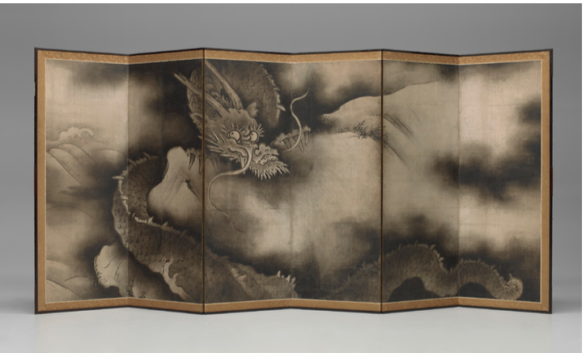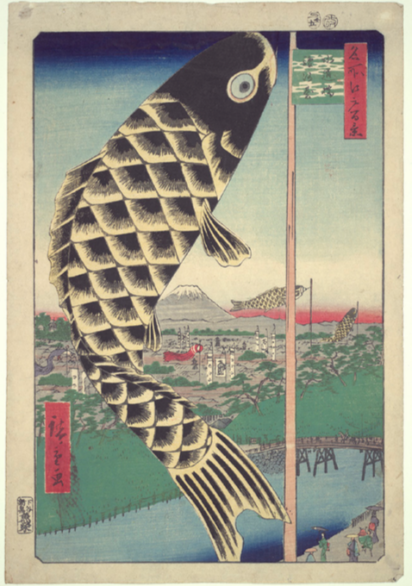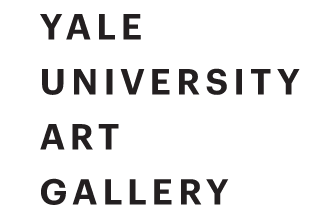A celebration of the dragon across media from the past 500 years,
coinciding with the 2024 Chinese Lunar New Year
March 15–November 10, 2024
~~~~~~~~~~~~~~~~~~~~~~~~~~~~~~~~~~~~~~~~

Momoyama period (1573–1615), ca. 1600–1615. Ink on paper. Yale University Art Gallery,
Gift of Rosemarie and Leighton R. Longhi, B.A. 1967.
January 18, 2024, New Haven, Conn.—The Yale University Art Gallery is pleased to present Year of the Dragon, an exhibition coinciding with the 2024 Chinese Lunar New Year that celebrates this mythical beast through nearly 30 artworks spanning from the 17th century to the present day. In the West, the dragon has historically been characterized as an evil creature, ying through the air while breathing re from its mouth, but in the East, the dragon is believed to possess power in the celestial realm and to pour out blessings in the form of rainwater over swirling wind.
The dragon also has a place in the Eastern zodiac calendar— alongside 11 other animals, such as the rabbit, snake, and tiger—in which each year is associated with an animal and its reputed attributes. The objects on view, which are largely drawn from the collection of the Yale University Art Gallery, feature dragons emerging from the clouds painted on folding screens, other paintings, textiles, ceramics, ivory, and woodblock prints.
Other works, such as Katsushika Hokusai’s well-known woodcut The Great Wave (ca. 1831), feature the wind and water elements that are often associated with the dragon. This object, along with the other light-sensitive works in Year of the Dragon, will be replaced with a new selection in July 2024, o ering repeat visitors a new experience of the exhibition. Taking inspiration from East Asian history, folklore, and myth, Year of the Dragon demonstrates a long, complex, and continuing artistic tradition around this fantastical creature.
————————————————–

Utagawa Hiroshige, Suidōbashi and Surugadai, from the series One Hundred Famous Views of Edo, Japan, Edo period (1615–1868), 5th month, leap year 1857. Polychrome woodblock print. Yale University Art Gallery, Hobart and Edward Small Moore Memorial Collection, Gift of Mrs. William H. Moore
————————————-
Exhibition Credits
Organized by Sadako Ohki, the Japan Foundation Associate Curator of Japanese Art.
Yale University Art Gallery
————————————-
 Founded in 1832, the Yale University Art Gallery is the oldest college art museum in America. Today, it is a center for teaching, learning, and scholarship and a preeminent cultural asset for Yale University, the wider academic community, and the public. The museum collects, preserves, studies, and presents art in all media, from all regions of the globe and across time, with a collection numbering nearly 300,000 objects.
Founded in 1832, the Yale University Art Gallery is the oldest college art museum in America. Today, it is a center for teaching, learning, and scholarship and a preeminent cultural asset for Yale University, the wider academic community, and the public. The museum collects, preserves, studies, and presents art in all media, from all regions of the globe and across time, with a collection numbering nearly 300,000 objects.
——————-
General Information
The Yale University Art Gallery is located at 1111 Chapel Street, New Haven, Connecticut.
Museum hours: Tuesday–Friday, 10 am–5 pm; Thursday until 8 pm (September–June); and Saturday– Sunday, 11 am–5 pm. The Gallery is closed Mondays and major holidays. Free and open to the public.
For general information, please call 203.432.0600 or visit the website at artgallery.yale.edu.
——————————
Images courtesy of Yale University Art Gallery.
—————————
Visit: AAQ Portfolio / Museum Architecture — Yale University Art Gallery
And
AAQ / Portfolio: Yale University Art Gallery by Jan Garden Castro
==================================================================

AAQ / Resource: Riverhead Toyota
__________________________________________________

